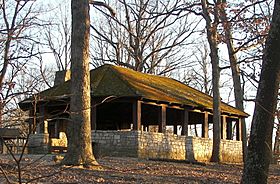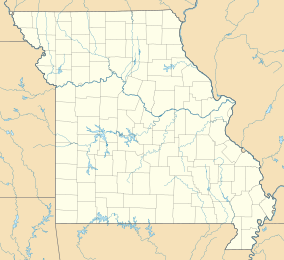Babler State Park facts for kids
Quick facts for kids Babler State Park |
|
|---|---|

Statue of Dr. Babler
|
|
| Location | Wildwood, Missouri, United States |
| Area | 2,441 acres (9.88 km2) |
| Elevation | 587 ft (179 m) |
| Established | 1937 |
| Governing body | Missouri Department of Natural Resources |
| Website | Babler State Park |
|
Dr. Edmund A. Babler Memorial State Park Historic District
|
|

CCC-constructed pavilion
|
|
| Location | Wildwood, Missouri |
| Area | 2,325 acres (941 ha) |
| Built | 1935 |
| Architect | CCC |
| Architectural style | Rustic |
| MPS | ECW Architecture in Missouri State Parks 1933-1942 TR |
| NRHP reference No. | 85000539 |
| Added to NRHP | February 27, 1985 |
Babler State Park, also known as Dr. Edmund A. Babler Memorial State Park, is a fun place to visit in Wildwood, Missouri. When you arrive, you'll see a large bronze statue of Dr. Babler himself!
This amazing state park covers about 2,441 acres (988 ha). It's a great spot for outdoor activities like hiking, picnicking, biking, horseback riding, and camping. The park is also very important historically. It was added to the National Register of Historic Places in 1985.
Contents
Park History
Who Was Dr. Edmund A. Babler?
The park was created to remember a special person named Edmund A. Babler. He was born in Appleton City, Missouri, on October 11, 1874. Edmund became a general surgeon after graduating from Missouri Medical College in 1898. This school is now known as Washington University Medical School.
Dr. Babler had a very busy private practice in St. Louis. People say he spent most of his time helping those who couldn't afford medical care. He was very proud of his work for people in need. Sadly, he passed away at age 55 from pneumonia, which is a serious lung infection. His funeral was one of the biggest ever held in St. Louis. This showed how much people respected and admired him.
How the Park Began
Edmund's brother, Jacob L. Babler, was very touched by the public's sadness. He wanted to find a way to keep his brother's memory alive. Jacob was a successful businessman who owned a lot of land.
On August 20, 1930, Jacob and his younger brother Henry Babler gave 868 acres of land to the State of Missouri. They wanted it to be named the Dr. Edmund A. Babler Memorial State Park. These were tough times in the world, known as the Great Depression. Even though they kept donating more land, Jacob needed help to develop the park.
He reached out to his friend, John J. Cochran, who was a Congressman. With Cochran's help, they got federal aid for the park. This aid came from the Civilian Conservation Corps (CCC). The CCC was a program where young men worked on public projects, like building parks, during the Great Depression. Two CCC camps were set up right inside Babler State Park to help build it.
Building and Dedicating the Park
With the help of Conrad Wirth, who was a director in the National Park System, plans were made. They created a special fund to pay for building, maintaining, and running the park. A state law was passed to officially accept the land. Governor Lloyd Stark signed it on June 23, 1937.
The park was officially opened on October 1, 1938. A big ceremony was held, and Harold Ickes, the Secretary of the Interior, spoke to about 3,500 guests. This was also when the statue of Dr. Babler was shown for the first time in its current spot.
Jacob Babler's Lasting Impact
Jacob Babler continued to support the park dedicated to his brother for the rest of his life. He also helped the entire Missouri State Park system. In 1944, he suggested a plan that set aside $400,000 each year for 15 years. This money was used to buy and develop more land for state parks in Missouri.
Thanks to Jacob L. Babler's support, many popular Missouri State Parks were created and improved between 1946 and 1960. He is known as the "Father of Missouri's State Parks" because of his amazing efforts.
Things to Do at Babler State Park
Babler State Park offers many fun activities for visitors:
- Several hiking trails for exploring nature.
- A paved bicycle trail that is about 2-mile (3.2 km) long.
- An equestrian trail, about 6-mile (9.7 km) long, for horseback riding.
- A campground where you can stay overnight.
- Plenty of picnic areas for outdoor meals with family and friends.



